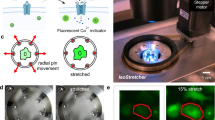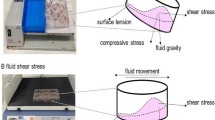Abstract
A commonly used technique to investigate strain-induced responses of adherent cells is culturing them on an elastic membrane and globally stretching the membrane. However, it is virtually impossible to acquire microscopic images immediately after the stretch with this method. Using a newly developed technique, we recorded the strain-induced increase of the cytoplasmic Ca2+ concentration ([Ca2+]c) in rat primary alveolar type II (ATII) cells at an acquisition rate of 30ms and without any temporal delay. We can show that the onset of the mechanically induced rise in [Ca2+]c was very fast (<30 ms), and Ca2+ entry was immediately abrogated when the stimulus was withdrawn. This points at a direct mechanical activation of an ion channel. RT-PCR revealed high expression of TRPV2 in ATII cells, and silencing TRPV2, as well as blocking TRPV channels with ruthenium red, significantly reduced the strain-induced Ca2+ response. Moreover, the usually homogenous pattern of the strain-induced [Ca2+]c increase was converted into a point-like response after both treatments. Also interfering with actin/myosin and integrin binding inhibited the strain-induced increase of [Ca2]c. We conclude that TRPV2 participates in strain-induced Ca2+ entry in ATII cells and suggest a direct mechanical activation of the channel that depends on FAs and actin/myosin. Furthermore, our results underline the importance of cell strain systems that allow high temporal resolution.
Similar content being viewed by others
References
Abramoff MD, Magelhaes PJ, Ram SJ (2004) Image processing with Image. J Biophotonics Int 11: 36–42
Akita T, Kuba K (2000) Functional triads consisting of ryanodine receptors, Ca(2+) channels, and Ca(2+)-activated K(+) channels in bullfrog sympathetic neurons. Plastic modulation of action potential. J Gen Physiol 116: 697–720
Alenghat FJ, Ingber DE (2002) Mechanotransduction: all signals point to cytoskeleton, matrix, and integrins. Sci STKE 2002: e6
Ashino Y, Ying X, Dobbs LG, Bhattacharya J (2000) [Ca2+]i oscillations regulate type II cell exocytosis in the pulmonary alveolus. Am J Physiol Lung Cell Mol Physiol 279: L5–L13
Caterina MJ, Rosen TA, Tominaga M, Brake AJ, Julius D (1999) A capsaicin-receptor homologue with a high threshold for noxious heat. Nature 398: 436–441
Chalfie M (2009) Neurosensory mechanotransduction. Nat Rev Mol Cell Biol 10: 44–52
Christensen AP, Corey DP (2007) TRP channels in mechanosensation: direct or indirect activation?. Nat Rev Neurosci 8: 510–521
Clapham DE (2007) SnapShot: mammalian TRP channels. Cell 129: 220
DeCrescenzo V, ZhuGe R, Velazquez-Marrero C, Lifshitz LM, Custer E, Carmichael J, Lai FA, Tuft RA, Fogarty KE, Lemos JR, Walsh JV Jr. (2004) Ca2+ syntillas, miniature Ca2+ release events in terminals of hypothalamic neurons, are increased in frequency by depolarization in the absence of Ca2+ influx. J Neurosci 24: 1226–1235
Dobbs LG, Gonzalez R, Williams MC (1986) An improved method for isolating type II cells in high yield and purity. Am Rev Respir Dis 134: 141–145
Frick M, Bertocchi C, Jennings P, Haller T, Mair N, Singer W, Pfaller W, Ritsch-Marte M, Dietl P (2004) Ca2+ entry is essential for cell strain-induced lamellar body fusion in isolated rat type II pneumocytes. Am J Physiol Lung Cell Mol Physiol 286: L210–L220
Geiger B, Spatz JP, Bershadsky AD (2009) Environmental sensing through focal adhesions. Nat Rev Mol Cell Biol 10: 21–33
Gerstmair A, Fois G, Innerbichler S, Dietl P, Felder E (2009) A device for simultaneous live cell imaging during uni-axial mechanical strain or compression. J Appl Physiol 107: 613–620
Gillespie PG, Walker RG (2001) Molecular basis of mechanosensory transduction. Nature 413: 194–202
Haller T, Auktor K, Frick M, Mair N, Dietl P (1999) Threshold calcium levels for lamellar body exocytosis in type II pneumocytes. Am J Physiol 277: L893–L900
Haller T, Ortmayr J, Friedrich F, Volkl H, Dietl P (1998) Dynamics of surfactant release in alveolar type II cells. Proc Natl Acad Sci USA 95: 1579–1584
Hamill OP, Martinac B (2001) Molecular basis of mechanotransduction in living cells. Physiol Rev 81: 685–740
Jin X, Touhey J, Gaudet R (2006) Structure of the N-terminal ankyrin repeat domain of the TRPV2 ion channel. J Biol Chem 281: 25006–25010
Kamm RD, Kaazempur-Mofrad MR (2004) On the molecular basis for mechanotransduction. Mech Chem Biosyst 1: 201–209
Katsumi A, Orr AW, Tzima E, Schwartz MA (2004) Integrins in mechanotransduction. J Biol Chem 279: 12001–12004
Ledbetter MW, Preiner JK, Louis CF, Mickelson JR (1994) Tissue distribution of ryanodine receptor isoforms and alleles determined by reverse transcription polymerase chain reaction. J Biol Chem 269: 31544–31551
Liedtke WB (2007) TRPV channels’ function in Osmo- and mechanotransduction. In: Liedtke WB, Heller S (eds) TRP ion channel function in sensory transduction and cellular signaling cascades p, Chap. 22. CRC Press, Boca Raton
Matthews BD, Thodeti CK, Tytell JD, Mammoto A, Overby DR, Ingber DE (2010) Ultra-rapid activation of TRPV4 ion channels by mechanical forces applied to cell surface beta1 integrins. Integr Biol (Camb) 2: 435–442
Mihara H, Boudaka A, Shibasaki K, Yamanaka A, Sugiyama T, Tominaga M (2010) Involvement of TRPV2 activation in intestinal movement through nitric oxide production in mice. J Neurosci 30: 16536–16544
Muraki K, Iwata Y, Katanosaka Y, Ito T, Ohya S, Shigekawa M, Imaizumi Y (2003) TRPV2 is a component of osmotically sensitive cation channels in murine aortic myocytes. Circ Res 93: 829–838
Na S, Collin O, Chowdhury F, Tay B, Ouyang M, Wang Y, Wang N (2008) Rapid signal transduction in living cells is a unique feature of mechanotransduction. Proc Natl Acad Sci USA 105: 6626–6631
Naraghi M, Neher E (1997) Linearized buffered Ca2+ diffusion in microdomains and its implications for calculation of [Ca2+] at the mouth of a calcium channel. J Neurosci 17: 6961–6973
Narita K, Akita T, Hachisuka J, Huang S, Ochi K, Kuba K (2000) Functional coupling of Ca(2+) channels to ryanodine receptors at presynaptic terminals. Amplification of exocytosis and plasticity. J Gen Physiol 115: 519–532
Neher E (1998) Vesicle pools and Ca2+ microdomains: new tools for understanding their roles in neurotransmitter release. Neuron 20: 389–399
Nicholas TE, Power JH, Barr HA (1982) The pulmonary consequences of a deep breath. Respir Physiol 49: 315–324
O’Neil RG, Heller S (2005) The mechanosensitive nature of TRPV channels. Pflugers Arch 451: 193–203
Orr AW, Helmke BP, Blackman BR, Schwartz MA (2006) Mechanisms of mechanotransduction. Dev Cell 10: 11–20
Patel AS, Reigada D, Mitchell CH, Bates SR, Margulies SS, Koval M (2005) Paracrine stimulation of surfactant secretion by extracellular ATP in response to mechanical deformation. Am J Physiol Lung Cell Mol Physiol 289: L489–L496
Perez R, Tupac-Yupanqui I, Dunner S (2008) Evaluation of suitable reference genes for gene expression studies in bovine muscular tissue. BMC Mol Biol 9: 79
Pfaffl MW (2001) A new mathematical model for relative quantification in real-time RT-PCR. Nucleic Acids Res 29: e45
Ramsey IS, Delling M, Clapham DE (2006) An introduction to TRP channels. Annu Rev Physiol 68: 619–647
Shibasaki K, Murayama N, Ono K, Ishizaki Y, Tominaga M (2010) TRPV2 enhances axon outgrowth through its activation by membrane stretch in developing sensory and motor neurons. J Neurosci 30: 4601–4612
Shin JB, Martinez-Salgado C, Heppenstall PA, Lewin GR (2003) A T-type calcium channel required for normal function of a mammalian mechanoreceptor. Nat Neurosci 6: 724–730
Venkatachalam K, Montell C (2007) TRP channels. Annu Rev Biochem 76: 387–417
Vlahakis NE, Hubmayr RD (2005) Cellular stress failure in ventilator-injured lungs. Am J Respir Crit Care Med 171: 1328–1342
Wei C, Wang X, Chen M, Ouyang K, Song LS, Cheng H (2009) Calcium flickers steer cell migration. Nature 457: 901–905
Wild JS, Giri SN, Moore R, Pessah IN (2000) Characterization of [3H]ryanodine binding sites in mammalian lung. Arch Biochem Biophys 379: 109–118
Wirtz HR, Dobbs LG (1990) Calcium mobilization and exocytosis after one mechanical stretch of lung epithelial cells. Science 250: 1266–1269
Author information
Authors and Affiliations
Corresponding author
Rights and permissions
About this article
Cite this article
Fois, G., Wittekindt, O., Zheng, X. et al. An ultra fast detection method reveals strain-induced Ca2+ entry via TRPV2 in alveolar type II cells. Biomech Model Mechanobiol 11, 959–971 (2012). https://doi.org/10.1007/s10237-011-0365-4
Received:
Accepted:
Published:
Issue Date:
DOI: https://doi.org/10.1007/s10237-011-0365-4




